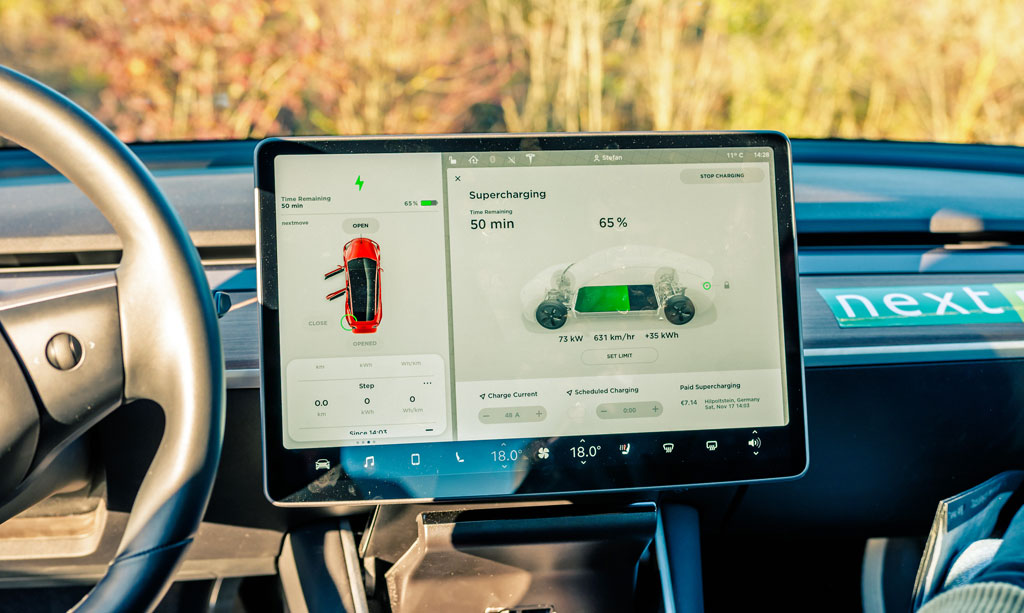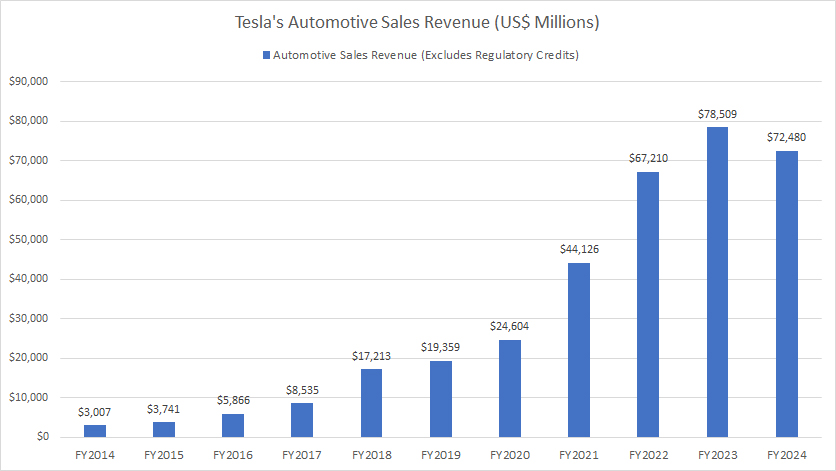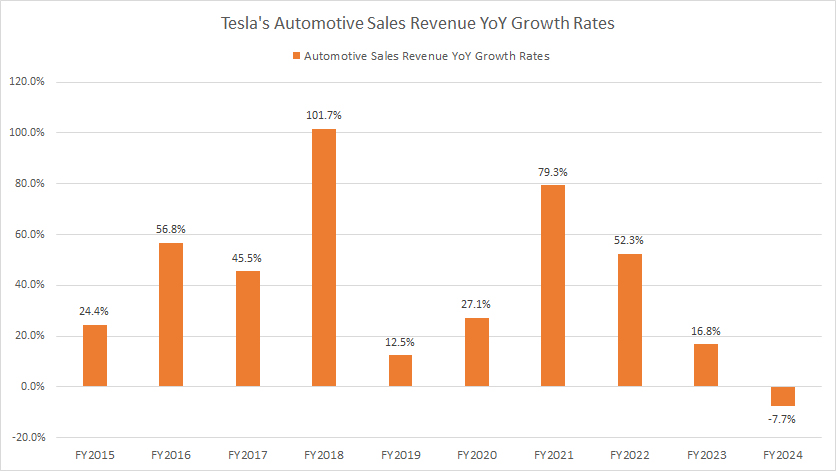
The Interior of a Model 3. Flickr Image.
This article presents Tesla’s car sales revenue excluding sales from regulatory credits.
Apart from the car revenue figures, we also look at the gross margin, growth rates, and ratio to total revenue.
Let’s take a look!
For other key statistics of Tesla, you may find more resources on these pages:
Sales
Revenue
Energy
Profit Margin
- Gross profit breakdown: automotive, energy, and services,
- Profit margin by segment: automotive, energy, and services,
- Gross profit and gross margin per car,
- Profit per employee,
R&D Comparison
Debt, Cash, and Liquidity
- Financial health: debt level, payment due, and liquidity,
- Cash flow and cash on hand analysis,
- Debt to equity, capital structure, and more,
- Liquidity check: current ratio, working capital, and quick ratio,
Comparison With Peers
- Marketing, advertising, and promotional spending,
- Tesla vs GM: profit margin comparison,
- Tesla vs Ford: vehicle profit and margin,
- Tesla vs BYD: profit margin comparison,
Other Statistics
- Interest expense and interest coverage ratio,
- Infrastructure expansion: supercharger stations, service fleets, and stores,
- Operating expenses breakdown analysis,
- Inventory breakdown analysis
Please use the table of contents to navigate this page.
Table Of Contents
Overview And Definitions
O2. Vehicles Deliveries Excluding Leased Units
Consolidated Result
Revenue Growth
B1. Car Sales Revenue YoY Growth Rates
Profitability
Revenue Ratio
D1. Car Sales Revenue to Total Revenue Ratio
Revenue Per Car
E1. Car Sales Revenue Per Vehicle
Conclusion And Reference
S1. Insight
S2. References and Credits
S3. Disclosure
Definitions
To help readers understand the content better, the following terms and glossaries have been provided.
Automotive Sales Revenue: Tesla’s automotive sales revenue or car sales revenue refers to the total amount of money earned by the company through the sale of electric vehicles. As of 2024, Tesla’s car sales revenue reached $72.5 billion.
This figure includes the sales of various models, such as the Model S, Model X, Model 3, and Model Y. Tesla has been experiencing steady growth in their car sales revenue over the years as more people are becoming interested in electric vehicles as a sustainable alternative to traditional gasoline-powered cars.
Regulatory Credits: Regulatory credits are a type of financial instrument that companies in the automotive industry earn for producing vehicles with lower carbon emissions than the regulatory requirements set by the government.
These credits can be bought and sold between companies and used to offset the emissions of vehicles that do not meet the regulatory requirements. In the case of Tesla, regulatory credits have been a significant source of revenue as the company has consistently exceeded the emissions standards set by various governments.
Vehicles Deliveries Excluding Leased Units
Tesla’s vehicles deliveries excluding leased cars
| As at 31 Dec | |||||||
|---|---|---|---|---|---|---|---|
| 2020 | 2021 | 2022 | 2023 | 2024 | |||
| Total Deliveries Excluding Leasing Units | 465,177 | 875,310 | 1,266,269 | 1,736,355 | 1,729,223 | ||
Tesla’s vehicles delivered (excluding leasing cars) in 2024 topped 1.7 million units worldwide, helped by record deliveries of Model 3 and Model Y.
Total Car Sales Revenue
Tesla-car-sales-revenue-by-year
(click image to expand)
Tesla experienced the first decline in its car sales revenue in fiscal year 2024, down by 8% year-over-year to $72.4 billion. This car sales revenue excludes regulatory credits sales.
The following table shows more detailed results:
Automotive Sales Revenue in FY2024:
| Category | Revenue |
|---|---|
| (US$ Billions) | |
| Automotive Sales | $72.5 |
3-Year Trend from FY2021 to FY2024:
| Category | Revenue | % Changes |
|---|---|---|
| (US$ Billions) | ||
| Automotive Sales | $44.1 to $72.5 | +64.3% |
5-Year Trend from FY2019 to FY2024:
| Category | Revenue | % Changes |
|---|---|---|
| (US$ Billions) | ||
| Automotive Sales | $19.4 to $72.5 | +274.4% |
10-Year Trend from FY2014 to FY2024:
| Category | Revenue | % Changes |
|---|---|---|
| (US$ Billions) | ||
| Automotive Sales | $3.0 to $72.5 | +2310.4% |
Car Sales Revenue YoY Growth Rates
Tesla-car-sales-revenue-YoY-growth-rates
(click image to expand)
Tesla’s car sales revenue has grown tremendously over the last decade. However, it experienced the first car sales revenue decline in fiscal year 2024 by 8% over the previous year.
The following table shows more detailed results:
Automotive Sales Revenue Growth in FY2024:
| Category | Growth Rate (%) |
|---|---|
| Automotive Sales | -7.7% |
3-Year Average from FY2022 to FY2024:
| Category | Growth Rate (%) |
|---|---|
| Automotive Sales | +20.5% |
5-Year Average from FY2020 to FY2024:
| Category | Growth Rate (%) |
|---|---|
| Automotive Sales | +33.6% |
10-Year Average from FY2015 to FY2024:
| Category | Growth Rate (%) |
|---|---|
| Automotive Sales | +40.9% |
Car Sales Gross Margin
Tesla-car-sales-gross-margin
(click image to expand)
Besides slowing revenue growth, Tesla’s car sales gross margin has also significantly declined since 2022.
The following table shows more detailed results:
Automotive Sales Gross Margin in FY2024:
| Category | Gross Margin (%) |
|---|---|
| Automotive Sales | 14.6% |
3-Year Trend from FY2021 to FY2024:
| Category | Gross Margin (%) | % Point Changes |
|---|---|---|
| Automotive Sales | 26.5% to 14.6% | -11.9% |
5-Year Trend from FY2019 to FY2024:
| Category | Gross Margin (%) | % Point Changes |
|---|---|---|
| Automotive Sales | 17.6% to 14.6% | -3.0% |
10-Year Trend from FY2014 to FY2024:
| Category | Gross Margin (%) | % Point Changes |
|---|---|---|
| Automotive Sales | 28.6% to 14.6% | -14.0% |
Car Sales Revenue To Total Revenue Ratio
Tesla-car-sales-revenue-to-total-revenue-ratio
(click image to expand)
Tesla’s car sales revenue used to contribute over 90% of the company’s total revenue, making it the company’s largest revenue source. However, this ratio has slowly declined over the years.
The following table shows more detailed results:
Automotive Sales Revenue Share in FY2024:
| Category | Revenue Share (%) |
|---|---|
| Automotive Sales | 74.2% |
3-Year Trend from FY2021 to FY2024:
| Category | Revenue Share (%) | % Point Changes |
|---|---|---|
| Automotive Sales | 82.0% to 74.2% | -7.8% |
5-Year Trend from FY2019 to FY2024:
| Category | Revenue Share (%) | % Point Changes |
|---|---|---|
| Automotive Sales | 78.8% to 74.2% | -4.6% |
10-Year Trend from FY2014 to FY2024:
| Category | Revenue Share (%) | % Point Changes |
|---|---|---|
| Automotive Sales | 94.0% to 74.2% | -19.8% |
Car Sales Revenue Per Vehicle
Tesla-car-sales-revenue-per-vehicle
(click image to expand)
Tesla’s car sales revenue per vehicle has steadily been on the decline despite the growing overall car sales revenue, as shown in the chart above.
The following table shows more detailed results:
Car Sales Revenue Per Vehicle in FY2024:
| Category | Revenue |
|---|---|
| (US$) | |
| Car Sales Revenue Per Vehicle | $41,915 |
3-Year Trend from FY2021 to FY2024:
| Category | Revenue | % Changes |
|---|---|---|
| (US$) | ||
| Car Sales Revenue Per Vehicle | $50,412 to $41,915 | -16.9% |
5-Year Trend from FY2019 to FY2024:
| Category | Revenue | % Changes |
|---|---|---|
| (US$) | ||
| Automotive Revenue Per Car | $56,569 to $41,915 | -25.9% |
10-Year Trend from FY2014 to FY2024:
| Category | Revenue | % Changes |
|---|---|---|
| (US$) | ||
| Automotive Revenue Per Car | $94,993 to $41,915 | -55.9% |
Insight
Tesla’s automotive sales revenue declined for the first time in fiscal year 2024, marking a significant moment in the company’s financial trajectory. The drop to $72.4 billion, reflecting a 7.7% year-over-year decrease, raises concerns about demand trends, competitive pressures, and pricing strategies.
While Tesla maintained strong vehicle deliveries — reaching 1.8 million units globally — the revenue contraction suggests a shift in market dynamics, possibly influenced by increased competition from Chinese EV manufacturers, pricing adjustments, and macroeconomic headwinds.
One of the key factors behind this decline is the downward trend in Tesla’s car sales revenue per vehicle, which fell to $41,915 in FY2024 — a stark contrast to $50,412 just three years prior. This decline is indicative of Tesla’s aggressive pricing strategies, particularly its price cuts aimed at sustaining demand amid an increasingly competitive EV landscape.
While lower prices can stimulate volume growth, they inevitably pressure margins, as evidenced by Tesla’s gross margin reduction from 26.5% in 2021 to just 14.6% in 2024. This decline suggests a potential erosion in profitability as cost-cutting efforts struggle to offset reductions in vehicle pricing.
Additionally, Tesla’s automotive revenue as a percentage of total revenue has steadily decreased over the years, falling from 94% in 2014 to 74.2% in 2024. This shift highlights the company’s diversification beyond vehicle sales into energy products, software, and services.
While these segments provide long-term growth potential, they are not yet substantial enough to cushion declining vehicle revenue. Tesla’s energy segment has shown promise, but its contribution remains relatively small compared to automotive sales.
From a broader strategic perspective, Tesla must balance volume growth with profitability as it navigates the next phase of EV adoption. Price competition with BYD and other emerging players will continue to be a challenge, forcing Tesla to innovate its cost structures while maintaining brand prestige.
The impact of global interest rates, consumer demand cycles, and supply chain constraints will also shape Tesla’s financial performance moving forward. Tesla’s financial trajectory underscores the challenges of scaling an EV business while maintaining robust profit margins.
With industry shifts toward affordability and mass adoption, Tesla’s ability to optimize operational efficiency, expand its software and services revenue streams, and manage pricing dynamics will determine its long-term sustainability. The 2024 revenue decline is a pivotal moment — whether it signals a temporary adjustment or a broader structural shift will depend on how Tesla strategically responds in the coming years.
References and Credits
1. All financial figures presented were obtained and referenced from Tesla’s quarterly and annual reports published on the company’s investor relations page: Tesla SEC Filings.
2. Flickr Images.
Disclosure
We may use artificial intelligence (AI) tools to assist us in writing some of the text in this article. However, the data is directly obtained from original sources and meticulously cross-checked by our editors multiple times to ensure its accuracy and reliability.
If you find the information in this article helpful, please consider sharing it on social media. Additionally, providing a link back to this article from any website can help us create more content like this in the future.
Thank you for your support and engagement! Your involvement helps us continue to provide high-quality, reliable content.





